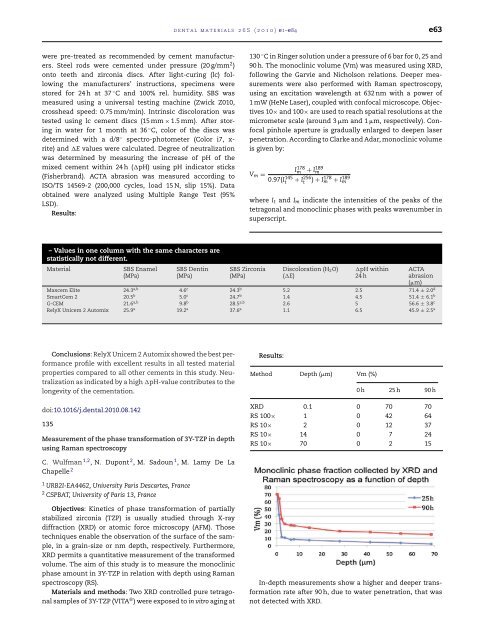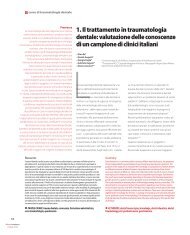Abstracts of the Academy of Dental Materials Annual ... - IsiRed
Abstracts of the Academy of Dental Materials Annual ... - IsiRed
Abstracts of the Academy of Dental Materials Annual ... - IsiRed
Create successful ePaper yourself
Turn your PDF publications into a flip-book with our unique Google optimized e-Paper software.
were pre-treated as recommended by cement manufacturers.<br />
Steel rods were cemented under pressure (20 g/mm 2 )<br />
onto teeth and zirconia discs. After light-curing (lc) following<br />
<strong>the</strong> manufacturers’ instructions, specimens were<br />
stored for 24 h at 37 ◦ C and 100% rel. humidity. SBS was<br />
measured using a universal testing machine (Zwick Z010,<br />
crosshead speed: 0.75 mm/min). Intrinsic discoloration was<br />
tested using lc cement discs (15 mm × 1.5 mm). After storing<br />
in water for 1 month at 36 ◦ C, color <strong>of</strong> <strong>the</strong> discs was<br />
determined with a d/8 ◦ spectro-photometer (Color i7, xrite)<br />
and �E values were calculated. Degree <strong>of</strong> neutralization<br />
was determined by measuring <strong>the</strong> increase <strong>of</strong> pH <strong>of</strong> <strong>the</strong><br />
mixed cement within 24 h (�pH) using pH indicator sticks<br />
(Fisherbrand). ACTA abrasion was measured according to<br />
ISO/TS 14569-2 (200,000 cycles, load 15 N, slip 15%). Data<br />
obtained were analyzed using Multiple Range Test (95%<br />
LSD).<br />
Results:<br />
– Values in one column with <strong>the</strong> same characters are<br />
statistically not different.<br />
Material SBS Enamel<br />
(MPa)<br />
dental materials 26S (2010) e1–e84 e63<br />
SBS Dentin<br />
(MPa)<br />
SBS Zirconia<br />
(MPa)<br />
Discoloration (H2O)<br />
(�E)<br />
�pH within<br />
24 h<br />
ACTA<br />
abrasion<br />
(�m)<br />
Maxcem Elite 24.3 a,b 4.6 c 24.3 b 5.2 2.5 71.4 ± 2.0 d<br />
SmartCem 2 20.5 b 5.0 c 24.7 b 1.4 4.5 51.4 ± 6.1 b<br />
G-CEM 21.6 a,b 9.8 b 28.5 a,b 2.6 5 56.6 ± 3.8 c<br />
RelyX Unicem 2 Automix 25.9 a 19.2 a 37.6 a 1.1 6.5 45.9 ± 2.5 a<br />
Conclusions: RelyX Unicem 2 Automix showed <strong>the</strong> best performance<br />
pr<strong>of</strong>ile with excellent results in all tested material<br />
properties compared to all o<strong>the</strong>r cements in this study. Neutralization<br />
as indicated by a high �pH-value contributes to <strong>the</strong><br />
longevity <strong>of</strong> <strong>the</strong> cementation.<br />
doi:10.1016/j.dental.2010.08.142<br />
135<br />
Measurement <strong>of</strong> <strong>the</strong> phase transformation <strong>of</strong> 3Y-TZP in depth<br />
using Raman spectroscopy<br />
C. Wulfman 1,2 , N. Dupont 2 , M. Sadoun 1 , M. Lamy De La<br />
Chapelle 2<br />
1 URB2I-EA4462, University Paris Descartes, France<br />
2 CSPBAT, University <strong>of</strong> Paris 13, France<br />
Objectives: Kinetics <strong>of</strong> phase transformation <strong>of</strong> partially<br />
stabilized zirconia (TZP) is usually studied through X-ray<br />
diffraction (XRD) or atomic force microscopy (AFM). Those<br />
techniques enable <strong>the</strong> observation <strong>of</strong> <strong>the</strong> surface <strong>of</strong> <strong>the</strong> sample,<br />
in a grain-size or nm depth, respectively. Fur<strong>the</strong>rmore,<br />
XRD permits a quantitative measurement <strong>of</strong> <strong>the</strong> transformed<br />
volume. The aim <strong>of</strong> this study is to measure <strong>the</strong> monoclinic<br />
phase amount in 3Y-TZP in relation with depth using Raman<br />
spectroscopy (RS).<br />
<strong>Materials</strong> and methods: Two XRD controlled pure tetragonal<br />
samples <strong>of</strong> 3Y-TZP (VITA ® ) were exposed to in vitro aging at<br />
130 ◦ C in Ringer solution under a pressure <strong>of</strong> 6 bar for 0, 25 and<br />
90 h. The monoclinic volume (Vm) was measured using XRD,<br />
following <strong>the</strong> Garvie and Nicholson relations. Deeper measurements<br />
were also performed with Raman spectroscopy,<br />
using an excitation wavelength at 632 nm with a power <strong>of</strong><br />
1 mW (HeNe Laser), coupled with confocal microscope. Objectives<br />
10× and 100× are used to reach spatial resolutions at <strong>the</strong><br />
micrometer scale (around 3 �m and 1 �m, respectively). Confocal<br />
pinhole aperture is gradually enlarged to deepen laser<br />
penetration. According to Clarke and Adar, monoclinic volume<br />
is given by:<br />
Vm =<br />
0.97(I 145<br />
t<br />
I178 m + I189 m<br />
+ I256<br />
t ) + I178 m + I189 m<br />
where It and Im indicate <strong>the</strong> intensities <strong>of</strong> <strong>the</strong> peaks <strong>of</strong> <strong>the</strong><br />
tetragonal and monoclinic phases with peaks wavenumber in<br />
superscript.<br />
Results:<br />
Method Depth (�m) Vm (%)<br />
0h 25h 90h<br />
XRD 0.1 0 70 70<br />
RS 100× 1 0 42 64<br />
RS 10× 2 0 12 37<br />
RS 10× 14 0 7 24<br />
RS 10× 70 0 2 15<br />
In-depth measurements show a higher and deeper transformation<br />
rate after 90 h, due to water penetration, that was<br />
not detected with XRD.



